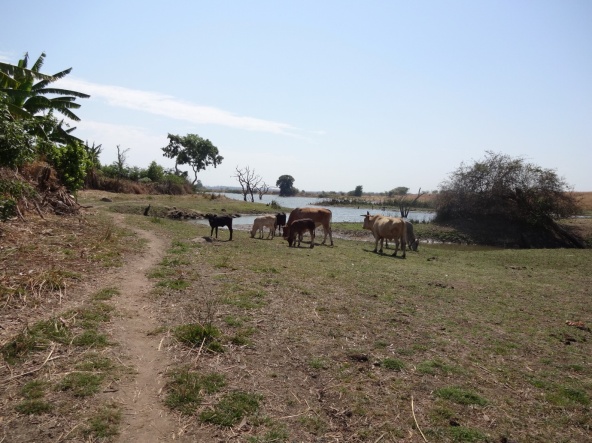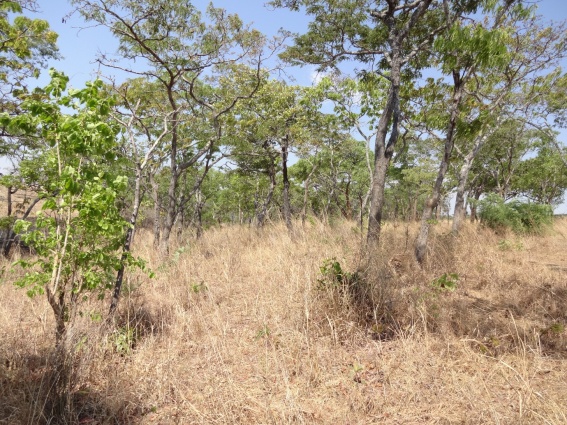In the “Making Tracks” series, RCC fellows and alumni present their experiences in environmental humanities, retracing the paths that led them to the Rachel Carson Center. For more information, please click here.
“Seeing the Hyenas for the Calves!”
One pitch dark night, it was storming heavily when my grandma, Grace Rungutai Kamutero, woke me up in my small, damp, grass-thatch hut at around two in the morning. She needed me to tend to the 40 cattle that had destroyed their kraal (pen). This was a herculean task for a seven-year-old boy—the bulls that had been fighting invariably resisted penning and would almost certainly gallop away from me. To complicate my task, the calves had also escaped their smaller kraal and were wandering about in the night. Goodness me, I had two kraals to repair, and then somehow had to find a way to herd the livestock back inside! As I struggled to herd the last of the animals into the warmth, I saw two hyenas circling my five calves—all of us now in grave danger…

From a village boy from the remote Kajiva Village in the Mount Darwin District in Zimbabwe, to a Rachel Carson Fellow in Munich, Germany, the story of my life borders on fiction.
I attended two rural primary schools (Chibara and Chahwanda Primary), whose registers were marked by more absences than attendances. I spent most of my time herding cattle and working food (maize) and cash (cotton) crop fields—a perfect opportunity to encounter and interact with the natural environment. Grazing pastures were home and I was in harmony with the flora and fauna around me. I could often be found perched on top of my favorite musuma and mupfuti trees, which afforded me a bird’s eye view of the surrounding landscape that rivaled that of the many birds in the thick forest. I knew most of their indigenous names and I relished trapping nesting doves!
I was knowledgeable of several tree species, especially those bearing edible fruits, such as matamba, nhunguru, nhengeni, matohwe, tsambati, suma,and maroro, which I frequently enjoyed. Grandma Grace taught me about the many uses of medicinal plants for ailments like headaches, stomach upset, snake bites, and general pain, and I knew which leaves, roots, and barks to use to treat myself. But trees were both a source of comfort and a menace to me—though they provided nourishment, medical care, and shelter from heavy downpours, I was terrified by the superstitions surrounding them. I had heard that during storms, witches sent lightning to strike down large trees to lay their eggs in them!

Most days, I would occupy myself with digging up edible roots to eat and to quench my thirst. Insects were both friend and foe. Sometimes, when watering the animals by the rivers, streams, and pools of the savanna grasslands, I would become lost in thought, admiring the bush, flowers, dragon flies, frogs, and fish; at other times, I was totally preoccupied with catching colored locusts and rodents. I lived and shared my existence with nature, talking to the birds, and cursing the snakes and thorns.
The liberation struggle for independence from British colonial rule interrupted my daily routine. Some of my closest friends were killed for being “informers.” The insecurity compelled my Aunt Margaret (a Watchtower believer) to steal me from Grandma Grace and take me to the south of the country. I completed elementary school there and began my secondary education, but soon ran into difficulty: I was expelled several times for lack of fees, but had the audacity to keep coming back! Eventually, after numerous threats from the principal, I returned one last time—to collect my belongings. One of my teachers, Sister Radegunda Muller, a kind-hearted German nun, took a personal interest in me and covered all of my fees. She introduced me to the mission orchard with its various artificially grown fruit trees, and this became my workplace during school holidays.
Afterwards, I moved to Bulawayo, Zimbabwe’s second largest city and trained as a high school teacher. My first posting was in Chinhoyi town, where I taught for two years. I resigned to study for an honors degree in Harare, the capital, after which I spent three years as the head of Magunje Secondary school in Karoi. I then pursued an MA degree in the urban environment of Harare and was later appointed as a lecturer at the University of Zimbabwe, after which I set my sights on studying for an MPhil and a DPhil at Oxford University. At Oxford, I studied social and economic history but specialized in environmental history, supervised by economic historian Charles Feinstein, and William Beinart, an environmental historian. Richard Grove examined my work and influenced my views on environmental history. In 2010, I came to Germany as a Humboldt senior researcher and later won the Gerda Henkel senior research fellowship to study modern Zimbabwe’s political environment. This was followed by a fellowship at The Rachel Carson Center, where I now find myself, to study the social and ecological transformations in Zimbabwe following a volatile land reform program in 2000.
My journey has taken me many miles from home, but I still think back to the night the calves and I faced the hyenas. That treacherous night, unbeknown to me, my uncle Jephias had snuck out to help herd the cattle back into the kraals; he shielded me from a potentially deadly midnight encounter with nature. My thoughts often turn to home, because that is where my past and future connect. It is these very experiences with the world around me that have given shape to my journey in environmental history, and I look forward to seeing where it leads me next.


Leave a Reply